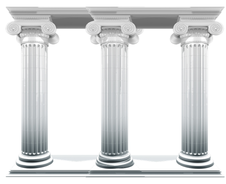Most modern people who have studied science in school believe that the Bible word “firmament” is merely a vague reference to the atmos above a spherical earth and the vast reaches of “outer space” beyond. That is why most Bible translators use English words like “expanse” for the Hebrew raqia. This is an example of translators’ bias. Raqia literally means something hard like beaten out metal. In Genesis 1:8, God called the firmament (raqia) heaven (shamayim). God used the firmament to separate the waters (mayim) below from those above. So above the firmament there was and is (Psalm 148:4) water. The shamayim contain mayim.
Therefore, the firmament is hard and strong enough to support the enormous weight of untold amounts of water.
The KJV and NKJV are faithful to the Hebrew and use the word “firmament” to communicate its solidity and strength.The Bible has some amazing revelations about the firmament besides its strength. Journey with me and allow yourself to consider that the firmament is real and exactly what the Bible says it is.
The first place outside of Genesis where we encounter the firmament is in Exodus when God invited Moses and the elders of Israel to dine with him.
Then Moses went up, also Aaron, Nadab, and Abihu, and seventy of the elders of Israel, 10 and they saw the God of Israel. And there was under His feet as it were a paved work of sapphire stone, and it was like the very heavens in its clarity. Exodus 24:9–10 (NKJV)
Obviously they were no longer on Mt. Sinai. It seems that God pulled them into heaven, much as he did with Ezekiel and John the Revelator later. Below are verses that describe those later occasions.
The likeness of the firmament above the heads of the living creatures was like the color of an awesome crystal, stretched out over their heads. 23 And under the firmament their wings spread out straight, one toward another. Each one had two which covered one side, and each one had two which covered the other side of the body. 24 When they went, I heard the noise of their wings, like the noise of many waters, like the voice of the Almighty, a tumult like the noise of an army; and when they stood still, they let down their wings. 25 A voice came from above the firmament that was over their heads; whenever they stood, they let down their wings. 26 And above the firmament over their heads was the likeness of a throne, in appearance like a sapphire stone; on the likeness of the throne was a likeness with the appearance of a man high above it. 27 Also from the appearance of His waist and upward I saw, as it were, the color of amber with the appearance of fire all around within it; and from the appearance of His waist and downward I saw, as it were, the appearance of fire with brightness all around. 28 Like the appearance of a rainbow in a cloud on a rainy day, so was the appearance of the brightness all around it. This was the appearance of the likeness of the glory of the LORD. So when I saw it, I fell on my face, and I heard a voice of One speaking. Ezekiel 1:22–28 (NKJV) Immediately I was in the Spirit; and behold, a throne set in heaven, and One sat on the throne. 3 And He who sat there was like a jasper and a sardius stone in appearance; and there was a rainbow around the throne, in appearance like an emerald. 4 Around the throne were twenty-four thrones, and on the thrones I saw twenty-four elders sitting, clothed in white robes; and they had crowns of gold on their heads. 5 And from the throne proceeded lightnings, thunderings, and voices. Seven lamps of fire were burning before the throne, which are the seven Spirits of God. 6 Before the throne there was a sea of glass, like crystal. And in the midst of the throne, and around the throne, were four living creatures full of eyes in front and in back. Revelation 4:2–6 (NKJV)
Below are some significant insights these verses provide.
- God inhabits a place where the hard “pavement” has a clarity like the sky, the color of sapphire or lapis lazuli.
- From below, the firmament looks like crystal. The Hebrew word here is qerach, which literally means frost or ice. The word for crystal from Revelation 5:6 uses the Greek word krustallos, which means congealed or transparent and is derived from a root word for frost.
- God’s throne rests on this sapphire-like pavement of the firmament and is also the color of sapphire. John likened the firmament below it to a sea of glass.
- The one who sits on the throne must be our Lord Jesus himself. In Exodus and Ezekiel this would have been a pre-incarnate theophany of the eternal Logos. We know from our Lord Jesus himself that God is a spirit whom heaven cannot contain, but Jesus acquired a human body and has been given authority to judge. It is he who sits on the throne as the glorious son of man prophesied by Daniel in a physical place called heaven located above the firmament.
- The rainbow appears at God’s throne, which reveals what a abomination it is that an inversion and corruption of this symbol now represents something quite anti-God. Could it be possible that the northern lights are expressions of God’s glory above the firmament? One day we will find out!
When God says he will roll up or split apart the heavens like a scroll, he means he will peel back the firmament to reveal the one who sits on the throne. (Isaiah 34:4 and Revelation 6:14)
At that point in history, every eye shall see him. The one who ascended through the heavens after his resurrection (Ephesians 4:10) will be revealed when the heavens are no more. Then God will create a new heaven and a new earth (2 Peter 3:13). Glory to God. What a day that will be!

